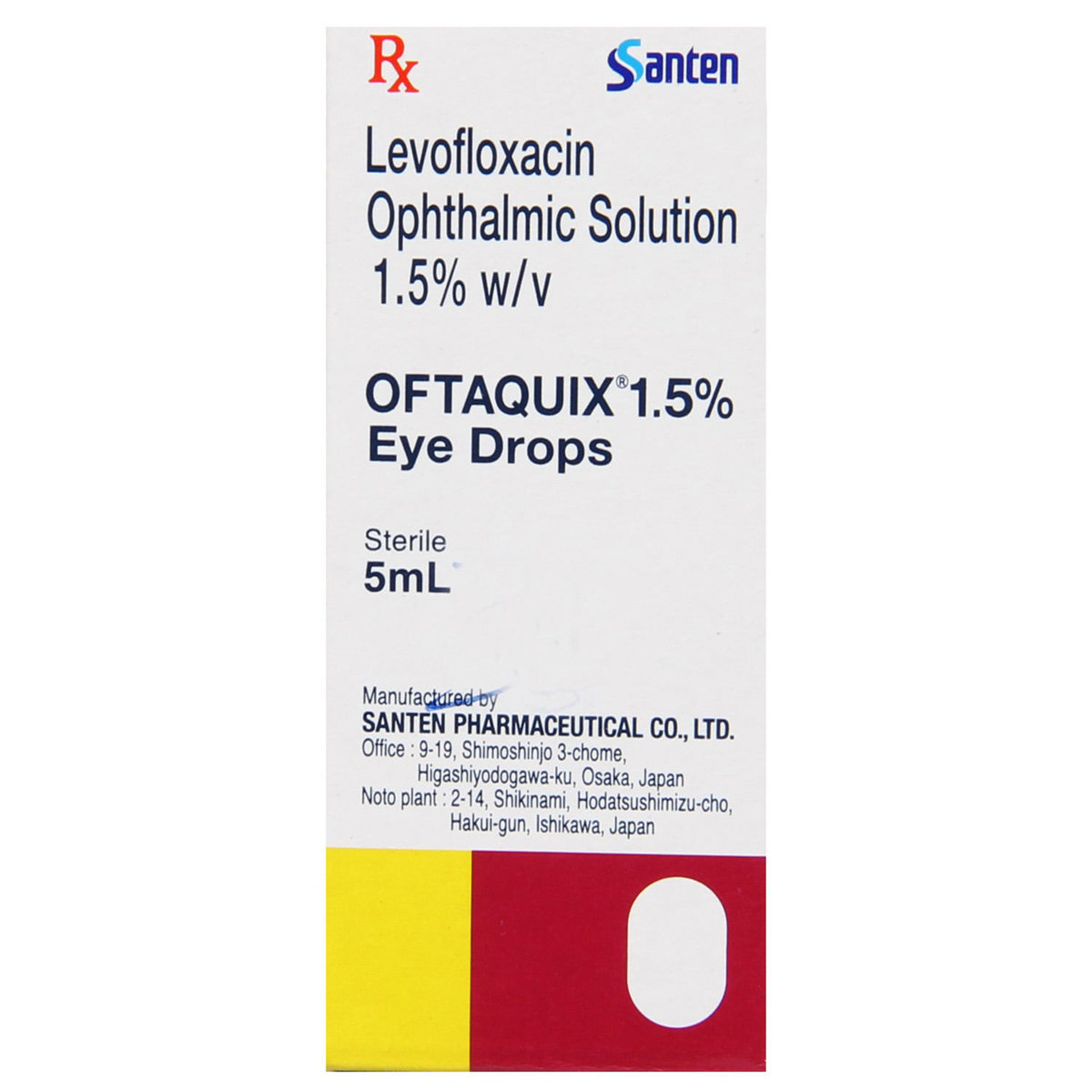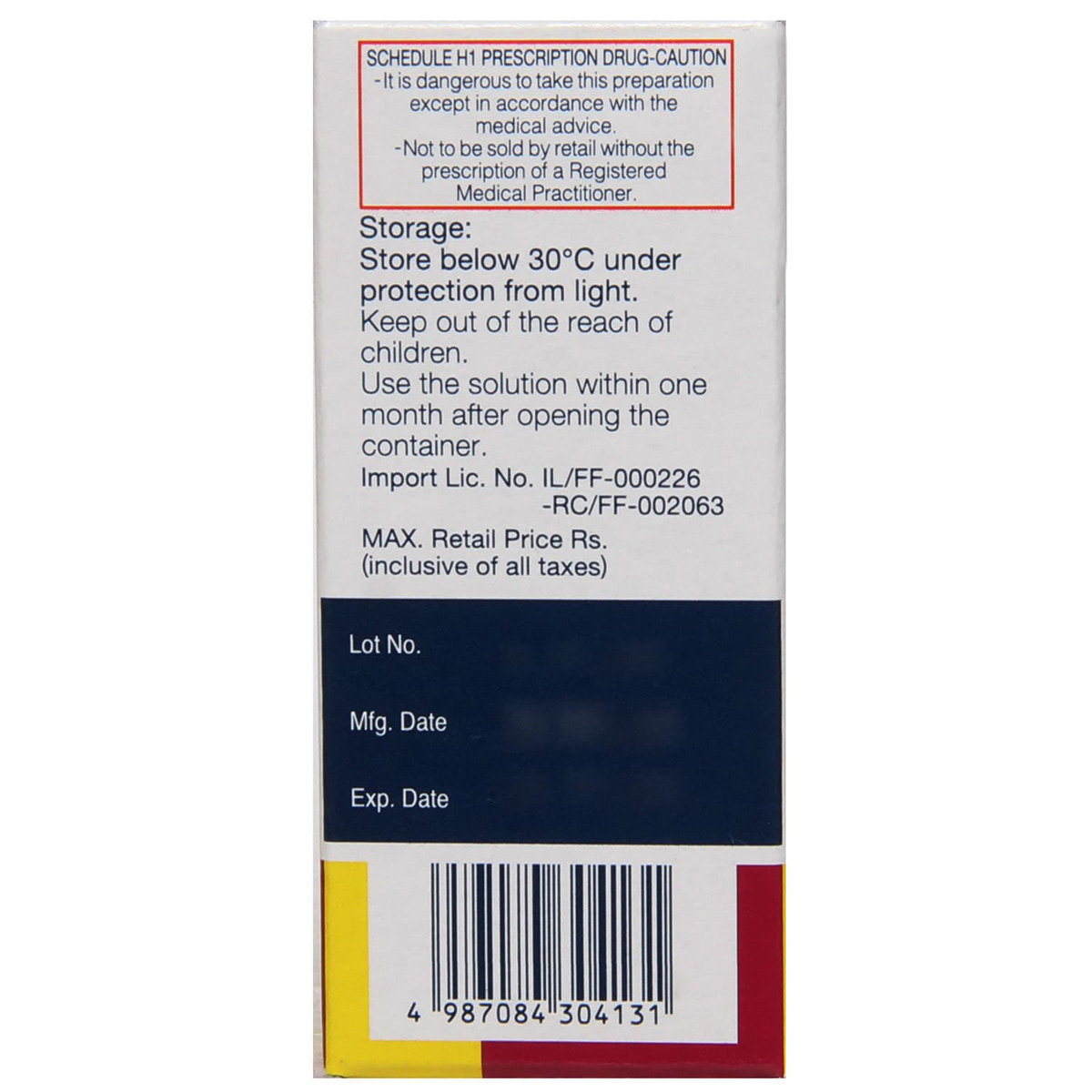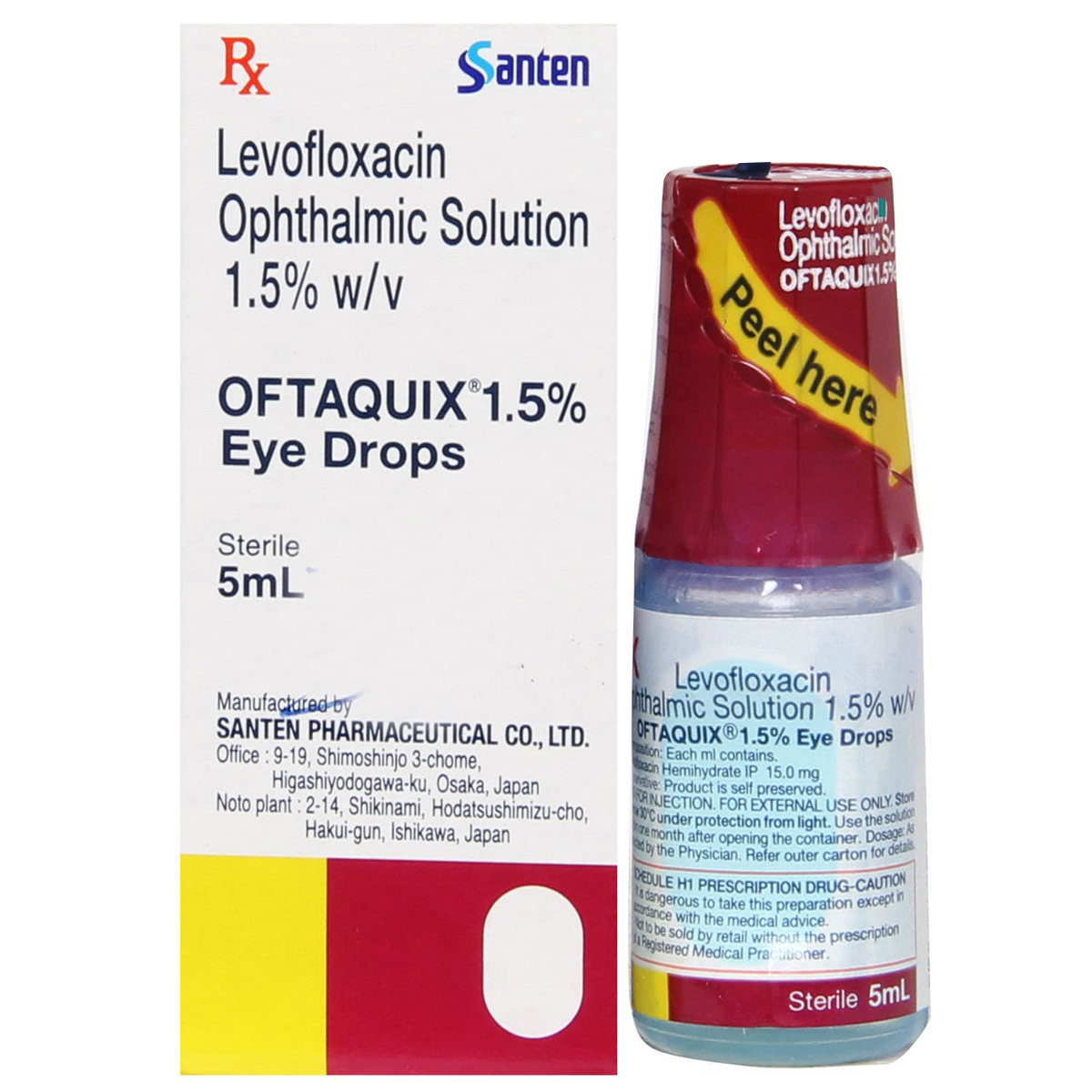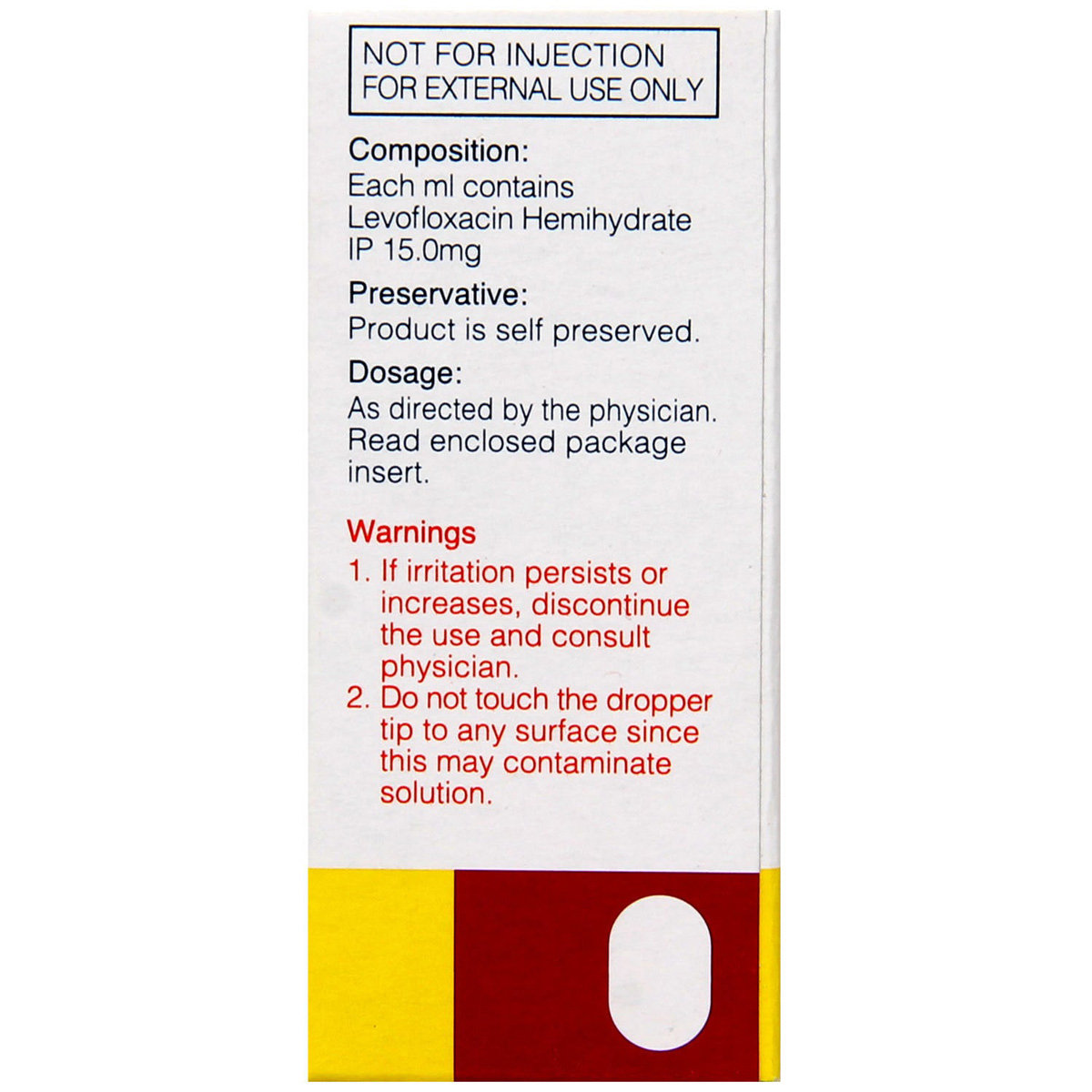Oftaquix 1.5% Eye Drops 5 ml








MRP ₹240
(Inclusive of all Taxes)
₹36.0 Cashback (15%)
Provide Delivery Location
Online payment accepted
 Prescription drug
Prescription drugWhats That
Composition :
Manufacturer/Marketer :
Consume Type :
Expires on or after :
Return Policy :
About Oftaquix 1.5% Eye Drops 5 ml
Oftaquix 1.5% Eye Drops 5 ml belongs to the group of antibiotics called fluoroquinolones used to treat bacterial infections of the eye. Bacterial eye infection occurs when harmful bacteria invade any part of the eye, such as the eyeball, conjunctiva, or cornea. Symptoms of an infection include red eyes, pain, discharge, watery/dry eyes, swelling, and itching.
Oftaquix 1.5% Eye Drops 5 ml contains Levofloxacin which works by killing the bacteria that cause infection. Thus, Oftaquix 1.5% Eye Drops 5 ml helps treat bacterial infection of the eye.
Oftaquix 1.5% Eye Drops 5 ml may cause common side effects such as a burning sensation, decreased vision or mucus in the eye. Most of these side effects do not require medical attention and will resolve gradually over time. However, you are advised to talk to your doctor if the side effects persist or worsen.
Consult your doctor before using Oftaquix 1.5% Eye Drops 5 ml if you are pregnant or breastfeeding. Avoid touching the tip of the dropper as it may contaminate the contents. Oftaquix 1.5% Eye Drops 5 ml may cause blurred vision; drive only if you have clear vision. Keep your doctor informed regarding your health condition and the medicines you are taking to prevent any side effects/interactions.
Uses of Oftaquix 1.5% Eye Drops 5 ml
Directions for Use
Key Benefits
Oftaquix 1.5% Eye Drops 5 ml belongs to the group of antibiotics called fluoroquinolones used to treat bacterial infections of the eye in adults and children above one year. Oftaquix 1.5% Eye Drops 5 ml contains Levofloxacin, which works by killing the bacteria that cause infection. Thereby, Oftaquix 1.5% Eye Drops 5 ml helps in treating bacterial infection of the eye.
Storage
- Hydrate your body: Drink enough water to prevent dehydration and headaches.
- Calm Your Mind: Deep breathing and meditation can help you relax and relieve stress.
- Rest and Recharge: Sleep for 7-8 hours to reduce headache triggers.
- Take rest: lie down in a quiet, dark environment.
- Cold or warm compresses can help reduce tension.
- Stay Upright: Maintain good posture to keep symptoms from getting worse.
- To treat headaches naturally, try acupuncture or massage therapy.
- Over-the-counter pain relievers include acetaminophen and ibuprofen.
- Prescription Assistance: Speak with your doctor about more substantial drug alternatives.
- Severe Headaches: Seek emergency medical assistance for sudden, severe headaches.
- Frequent Headaches: If you get reoccurring headaches, consult your doctor.
- Headaches with Symptoms: Seek medical attention if your headaches include fever, disorientation, or weakness.
Drug Warnings
Do not use Oftaquix 1.5% Eye Drops 5 ml if you are allergic to any of its components. Consult your doctor if you are pregnant or breastfeeding. Talk to your doctor if the symptoms worsen or if it persists despite using Oftaquix 1.5% Eye Drops 5 ml for the prescribed duration. Let your doctor know if you are using any other medicines.
Drug-Drug Interactions
Drug-Drug Interactions
Login/Sign Up
The combination of Amiodarone and Oftaquix 1.5% Eye Drops 5 ml may significantly raise the risk of an abnormal heart rhythm.
How to manage the interaction:
Despite the fact that Amiodarone and Oftaquix 1.5% Eye Drops 5 ml interact, it can be taken if prescribed by a doctor. If you get dizziness, lightheadedness, fainting, or fast or racing heartbeats, consult a doctor. Do not stop taking any medications without visiting a doctor.
Taking Oftaquix 1.5% Eye Drops 5 ml with Ziprasidone can increase the risk of abnormal heart rhythm.
How to manage the interaction:
Taking Oftaquix 1.5% Eye Drops 5 ml with Ziprasidone is not recommended, but it can be taken together if prescribed by a doctor. However, consult your doctor if you experience sudden dizziness, lightheadedness, fainting, shortness of breath. Do not discontinue any medications without consulting a doctor.
Combining Oftaquix 1.5% Eye Drops 5 ml with Disopyramide can increase the risk of irregular heart rhythm .
How to manage the interaction:
Taking Oftaquix 1.5% Eye Drops 5 ml with Disopyramide is not recommended, as it can result in an interaction, it can be taken if your doctor has advised it. However, if you experience any symptoms like sudden dizziness, lightheadedness, fainting, or fast or pounding heartbeats, contact your doctor immediately. Do not discontinue any medications without first consulting your doctor.
Using sotalol together with Oftaquix 1.5% Eye Drops 5 ml can increase the risk of an irregular heart rhythm that may be serious. The risk increases in patients with a history of heart illness or electrolyte imbalance.
How to manage the interaction:
Taking Oftaquix 1.5% Eye Drops 5 ml with Sotalol is generally avoided as it can result in an interaction, it can be taken if your doctor has advised it. If you experience sudden dizziness, lightheadedness, fainting, or fast or pounding heartbeats, contact a doctor immediately. Do not discontinue any medications without consulting a doctor.
Coadministration of Oftaquix 1.5% Eye Drops 5 ml with Haloperidol can increase the risk or severity of irregular heart rhythms. The risk increases in patients with a history of heart illness or electrolyte imbalance.
How to manage the interaction:
Taking Oftaquix 1.5% Eye Drops 5 ml with haloperidol can result in an interaction, but it can be taken if a doctor has advised it. However, if you experience abrupt dizziness, lightheadedness, fainting, shortness of breath, or rapid heartbeat, get medical help immediately. Do not discontinue any medications without consulting a doctor.
Although it is a very rare adverse effect, taking Oftaquix 1.5% Eye Drops 5 ml with vemurafenib increases the risk of an abnormal heart rhythm. If you're dealing with other heart illnesses, electrolyte imbalances (for example, magnesium or potassium loss likely due to serious or prolonged diarrhea or vomiting), you may be at greater risk.
How to manage the interaction:
Although concomitant administration of Oftaquix 1.5% Eye Drops 5 ml with vemurafenib can possibly result in an interaction, it can be taken if your doctor has advised it. However, if you experience abrupt dizziness, lightheadedness, fainting, shortness of breath, or rapid heartbeat, get medical help immediately. Do not discontinue any medications without consulting a doctor.
Taking Oftaquix 1.5% Eye Drops 5 ml with anagrelide increases the risk of an abnormal heart rhythm.
How to manage the interaction:
Concomitant administration of Oftaquix 1.5% Eye Drops 5 ml alongside anagrelide can result in an interaction, it can be taken if a doctor has advised it. However, if you experience abrupt dizziness, lightheadedness, fainting, shortness of breath, or rapid heartbeat, get medical help immediately. Do not discontinue any medications without consulting a doctor.
Coadministration of Oftaquix 1.5% Eye Drops 5 ml and Leflunomide can increase the risk of liver issues.
How to manage the interaction:
Although concomitant administration of Oftaquix 1.5% Eye Drops 5 ml alongside leflunomide can result in an interaction, it can be taken if a doctor has advised it. However, if you have a fever, chills, joint pain or swelling, unusual bleeding or bruising, skin rash, itching, loss of appetite, fatigue, nausea, vomiting, abdominal pain, dark-colored urine, light-colored stools, and/or yellowing of the skin or eyes, contact the doctor right away. Do not discontinue any medications without consulting a doctor.
Coadministration of Oftaquix 1.5% Eye Drops 5 ml and Pasireotide can increase the risk of an irregular heart rhythm.
How to manage the interaction:
Taking Oftaquix 1.5% Eye Drops 5 ml with Pasireotide together can result in an interaction, but it can be taken if a doctor has advised it. If you have any symptoms like an irregular heartbeat, dizziness, fainting, or trouble breathing, you should call a doctor right away. Do not stop using any medications without talking to a doctor.
Using dofetilide together with Oftaquix 1.5% Eye Drops 5 ml can increase the risk of an irregular heart rhythm.
How to manage the interaction:
Although there is a possible interaction between Oftaquix 1.5% Eye Drops 5 ml and Dofetilide, you can take these medicines together if prescribed by a doctor. If you experience symptoms like an irregular heart rhythm, dizziness, fainting, or shortness of breath, it's important to call a doctor right away. Do not stop using any medications without a doctor's advice.
Drug-Food Interactions
Drug-Food Interactions
Login/Sign Up
Diet & Lifestyle Advise
- Wash your hands regularly. Avoid touching the eyes with dirty hands.
- Avoid rubbing the eyes.
- Avoid sharing eye makeup such as eyeliner, mascara or kohl.
- Always use clean towels or tissues to wipe your eyes and face.
- Regularly wash and change the pillowcases.
- If you wear contact lenses, clean and replace contact lenses more often. Never share contact lenses. Remember to wash your hands before inserting and after removing the contact lens.
- Avoid staring at digital screens for longer durations. Rest your eyes every 20 minutes.
- Blink regularly as it helps in the spread of hydrating substances such as mucus and tears across the eyes.
Side Effects of Oftaquix 1.5% Eye Drops 5 ml
- Burning sensation
- Decreased vision
- Mucus in the eye
Habit Forming
Therapeutic Class
All Substitutes & Brand Comparisons
Author Details
We provide you with authentic, trustworthy and relevant information
Drug-Diseases Interactions
Drug-Diseases Interactions
Login/Sign Up
FAQs
Oftaquix 1.5% Eye Drops 5 ml works by killing the bacteria that cause infection. Thus, it treats bacterial eye infections.
Using spectacles and avoiding wearing contact lenses is recommended until the infection is cleared. Do not wear contact lenses until 24 hours after the symptoms have subsided.
Oftaquix 1.5% Eye Drops 5 ml can be used with other eye medications if prescribed by the doctor. Maintain a gap of 15 minutes between Oftaquix 1.5% Eye Drops 5 ml and other eye medications.
Disease/Condition Glossary
Bacterial eye infections: Bacterial eye infection occurs when harmful bacteria invade any part of the eye, such as the eyeball, conjunctiva, or cornea. Symptoms of an infection include red eye, pain, discharge, watery/dry eyes, swelling, itching, and sensitivity to light. The common bacterial eye infections are conjunctivitis, stye, and keratitis. Conjunctivitis (pink eye) is the infection/inflammation of the conjunctiva (white part of the eye) and the inner eyelid. A stye is a bump on the eyelid or base of eyelashes. Keratitis is the inflammation of the cornea. It is a common problem in people who wear contact lenses.

Have a query?
Buy best Ocular products by
Entod Pharmaceuticals Ltd
Ajanta Pharma Ltd
Sunways (India) Pvt Ltd
Sun Pharmaceutical Industries Ltd
Cipla Ltd
Micro Labs Ltd
Allergan Healthcare India Pvt Ltd
Intas Pharmaceuticals Ltd
Raymed Pharmaceuticals Ltd
Nri Vision Care India Ltd
FDC Ltd
Jawa Pharmaceuticals India Pvt Ltd
Indoco Remedies Ltd
Sapient Laboratories Pvt Ltd
Senses Pharmaceuticals Pvt Ltd
Centaur Pharmaceuticals Pvt Ltd
Neomedix Healthcare India Pvt Ltd
Aromed Pharmaceuticals
Optho Remedies Pvt Ltd
Aurolab
Austrak Pvt Ltd
Lupin Ltd
Mankind Pharma Pvt Ltd
Zivira Labs Pvt Ltd
Optho Pharma Pvt Ltd
Synovia Life Sciences Pvt Ltd
Akumentis Healthcare Ltd
Eyekare
His Eyeness Ophthalmics Pvt Ltd
Protech Remedies Pvt Ltd
Runyon Pharmaceutical Pvt Ltd
Alcon Laboratories Inc
Syntho Pharmaceuticals Pvt Ltd
Alembic Pharmaceuticals Ltd
Bell Pharma Pvt Ltd
Klar Sehen Pvt Ltd
Sentiss Pharma Pvt Ltd
Irx Pharmaceuticals Pvt Ltd
Optho Life Sciences Pvt Ltd
Phoenix Remedies Pvt Ltd
Alkem Laboratories Ltd
Doctor Wonder Pvt Ltd
Hicare Pharma
Ipca Laboratories Ltd
Neon Laboratories Ltd
Okulus Drugs India
Pharmtak Ophthalmics (I) Pvt Ltd
Berry & Herbs Pharma Pvt Ltd
Glow Vision Pharmaceuticals
Kaizen Drugs Pvt Ltd
Choroid Laboratories Pvt Ltd
Indiana Opthalamics Pvt Ltd
Optica Pharmaceutical Pvt Ltd
Pharmatak Opthalmics India Pvt Ltd
Samarth Life Sciences Pvt Ltd
Vibgyor Vision Care
Mofon Drugs
Novartis India Ltd
Pharmia Biogenesis Pvt Ltd
Zydus Cadila
Appasamy Ocular Devices Pvt Ltd
Leeford Healthcare Ltd
Medivision Pharma Pvt Ltd
Orbit Life Science Pvt Ltd
X-Med Royal Pharma Pvt Ltd
Zee Laboratories Ltd
Aarma Laboratories
Guerison MS Inc
Laborate Pharmaceuticals India Ltd
Xtas Pharmaceuticals
Accurex Biomedical Pvt Ltd
Blucrab Pharma Pvt Ltd
Does Health Systems Pvt Ltd
Flagship Biotech International Pvt Ltd
Lavue Pharmaceuticals Pvt Ltd
Nutrilis Healthcare Pvt Ltd
Ursa Pharm India Pvt Ltd
Vee Remedies
Vyonics Health Care India Pvt Ltd
Warren Pharmaceuticals Pvt Ltd
Abbott India Ltd
Accvus Pharmaceuticals
Akums Drugs & Pharmaceuticals Ltd
Cadila Healthcare Ltd
Carevision Pharmaceuticals Pvt Ltd
Dey's Medical Stores (Mfg) Ltd
East West Pharma India Pvt Ltd
Eyedea Pharmaceuticals Pvt Ltd
Nimbus Healthcare Pvt Ltd
Ocuris Pharmaceuticals Pvt Ltd
Sherings Pharmaceuticals
Tarks Pharmaceuticals Pvt Ltd
Vcan Biotech
Vision Medilink
Aice Health Care Pvt Ltd
Appasamy Pharmaceuticals Pvt Ltd
Asperia Lifescience Pvt Ltd
Beatum Healthcare Pvt Ltd
East India Pharmaceutical Works Ltd
Grevis Pharmaceutical Pvt Ltd
Alcohol
Safe if prescribed
It is not known whether Oftaquix 1.5% Eye Drops 5 ml interacts with alcohol. Please consult your doctor.
Pregnancy
Consult your doctor
Please consult your doctor before using Oftaquix 1.5% Eye Drops 5 ml if you are pregnant; your doctor will prescribe only if the benefits outweigh the risks.
Breast Feeding
Consult your doctor
Please consult your doctor if you are breastfeeding; your doctor will decide whether Oftaquix 1.5% Eye Drops 5 ml can be used by breastfeeding mothers.
Driving
Safe if prescribed
Oftaquix 1.5% Eye Drops 5 ml might blur your vision. So, avoid driving or operating machinery until your vision is clear.
Liver
Consult your doctor
Please consult your doctor if you have liver impairment before using Oftaquix 1.5% Eye Drops 5 ml.
Kidney
Consult your doctor
Please consult your doctor if you have kidney impairment before using Oftaquix 1.5% Eye Drops 5 ml.
Children
Safe if prescribed
Oftaquix 1.5% Eye Drops 5 ml is not recommended for children below one year. Oftaquix 1.5% Eye Drops 5 ml should be used in children only if prescribed by a doctor.



_0.jpg?tr=q-85)

